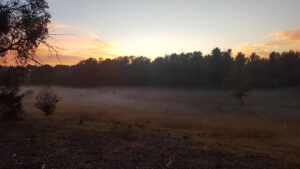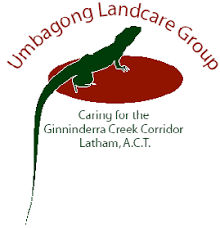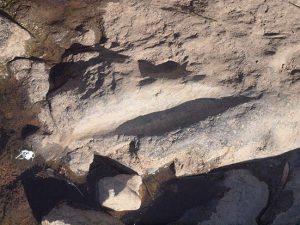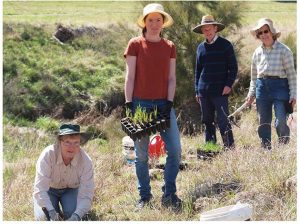Geographic focus: Umbagong District Park, Latham, along the Ginninderra Creek Corridor between Ginninderra Drive and Southern Cross Drive.
Photo below: Umbagong kangaroos in the mist, by Rick Nehmy, 2018.



Regular Activities and Working Bees: First Saturday of each month from 9am to 11am (summer is from 8am to 10am). If this day is a Public Holiday, the working bee is shifted to the following weekend. Our activities range from invasive weed management, native grass and woodland restoration, rubbish removal and erosion control, to community awareness-raising and education. We also monitor the sustainability, safety and amenity of the park and its native species (see extensive flora and fauna lists at the bottom of this page).
Please contact us if you would like to come along to one of our upcoming activities. No previous experience is needed! We will add you to our mailing list and send you details of the next meetup, including times and meeting location.
Contact: via the Ginninderra Catchment Group, phone 02 6278 3309, email: landcare@ginninderralandcare.org.au, or join the Umbagong District Park Landcare Facebook Group.
About Us: Umbagong Landcare Group had its origins in the 1980s when a group of residents campaigned through the (then) Ginninderra Community Council, to  preserve the creek corridor for the public and to have the area gazetted as District Park. The push to have the area protected was partly driven by archaeological discoveries in 1978 (heritage listed in 1984). The residents went on to form the Friends of Latham District Park in 1990 to protect the park’s Aboriginal heritage and to restore its remnant native vegetation. In partnership with the local Aboriginal community, the group facilitated a name change to Umbagong District Park in 1994, which recognises its importance to Aboriginal people (“Umbagong” means “axe” in the Ngunawal language), and the group became Umbagong Landcare Group. For more information on cultural heritage along Ginninderra Creek and at Umbagong District Park, go to Aboriginal Landcare.
preserve the creek corridor for the public and to have the area gazetted as District Park. The push to have the area protected was partly driven by archaeological discoveries in 1978 (heritage listed in 1984). The residents went on to form the Friends of Latham District Park in 1990 to protect the park’s Aboriginal heritage and to restore its remnant native vegetation. In partnership with the local Aboriginal community, the group facilitated a name change to Umbagong District Park in 1994, which recognises its importance to Aboriginal people (“Umbagong” means “axe” in the Ngunawal language), and the group became Umbagong Landcare Group. For more information on cultural heritage along Ginninderra Creek and at Umbagong District Park, go to Aboriginal Landcare.
Photo on the right: Axe grinding grooves in Ginninderra Creek at Umbagong District Park.
Umbagong Landcare Group is a small group of active volunteers who attend monthly working bees. Our working bees are just 2 hours long so people can fit in other activities on their busy weekends. Some members also undertake individual activities, focusing on a particular patch or a weed species in the park. Our volunteers bring a range of knowledge and skills to our activities, and some participate in various flora and fauna surveys. We share our enthusiasm for the creek and its habitats with the scores of people who visit the area.
We have a broad interest in environmental and community issues and a particular interest in the axe-grinding groove site near the junction of Macrossan Crescent and Backhouse Street. We also support research in finding the best way of promoting native grassland regeneration – an activity that will benefit all of the ACT.
Photo: Umbagong Landcare Group members removing woody weeds, and during a biodiversity planting in native grassland at Umbagong .



About Umbagong District Park: The park is an area of roughly 50 hectares of grassy woodland that extends either side of Ginninderra Creek between Ginninderra Drive and Southern Cross Drive. Prior to European settlement, the rich riparian habitat at Umbagong was of great importance to Ngunawal people. It was converted to grazing land in the 1820s. Then in the late 1960s and 1970s, the area either side of the creek was developed for residential housing (now Latham and Macgregor).
The creek corridor is now reserved as District Park. Umbagong continues to be an important natural wildlife corridor. Umbagong’s temperate native grassland is listed in the ACT’s Lowland Native Grassland Conservation Strategy (site BE04) and over the years, the once-denuded grazing land has been replanted with both exotic trees (amenity plantings) and native trees and shrubs, that now provide excellent bird habitat. Umbagong Landcare Group members have recorded roughly 120 species of birds, and Ca roline is currently working on a photographic fungi library- see the amazing photos in the link below. It is also home to many species of insect and reptile and a small population of kangaroos. There are occasional sightings of swamp wallaby, echidna, turtle and rakali (native water rat). Species lists can be found in the survey reports below. Photos can also be found on Canberra Nature Map.
roline is currently working on a photographic fungi library- see the amazing photos in the link below. It is also home to many species of insect and reptile and a small population of kangaroos. There are occasional sightings of swamp wallaby, echidna, turtle and rakali (native water rat). Species lists can be found in the survey reports below. Photos can also be found on Canberra Nature Map.
- Submission: Umbagong Bridges – Development Application Number 202240445, 16 August 2022
- Flood clean-up at Umbagong District Park – August 2022
- Management of the Lower Ginninderra Creek Report
- Umbagong LCG Strategic Plan
- Lets Discover Umbagong District Park Brochure
- Umbagong Bird List, updated 2020, in alphabetical order and in categories
- Crawford Umbagong Wildlife Survey 2000
- Umbagong Flora and Fauna Survey 1992
- Umbagong Flora and Fauna Survey 92-93
- Umbagong Fungi Project 2020 Part 1
- Umbagong Fungi Project 2020 Part 2
- Umbagong Fungi Project 2020 Part 3
- Umbagong Fungi Project 2020 Part 4
Lucy’s Bird List story
 Lucy Wenger started surveying birds in 2009-2010. She was a bird lover (owner of a stray cockatiel – still alive and squawking!) and school had asked its students to prepare a ‘personal project’ on something that interested them. At the start of the project Lucy could tell a magpie from a currawong but not a yellow rump thornbill from a striated. For a whole year, she learnt how to identify, observe and photograph them at Umbagong District Park, Goodwin Hill and in her own back garden located in between. In 2010, young Lucy presented her results, totalling 68 bird species in her study areas, at the GCG AGM and Christmas party to a captivated audience (right: Lucy’s first bird surveys in 2009 – a camera was indispensable while learning to identify birds, below: presenting results at the 2010 GCG Christmas Party).
Lucy Wenger started surveying birds in 2009-2010. She was a bird lover (owner of a stray cockatiel – still alive and squawking!) and school had asked its students to prepare a ‘personal project’ on something that interested them. At the start of the project Lucy could tell a magpie from a currawong but not a yellow rump thornbill from a striated. For a whole year, she learnt how to identify, observe and photograph them at Umbagong District Park, Goodwin Hill and in her own back garden located in between. In 2010, young Lucy presented her results, totalling 68 bird species in her study areas, at the GCG AGM and Christmas party to a captivated audience (right: Lucy’s first bird surveys in 2009 – a camera was indispensable while learning to identify birds, below: presenting results at the 2010 GCG Christmas Party).
Lucy’s school project did not end there but became an enduring interest.

The data from her 2010 survey formed the baseline for her Umbagong bird survey and she has continued to build on it. Ten years on, she has recently updated her bird list again, and the number of species she has identified at Umbagong has grown to 120 (see above). When she is not “playing” at Umbagong, she surveys birds professionally for Greening Australia.
